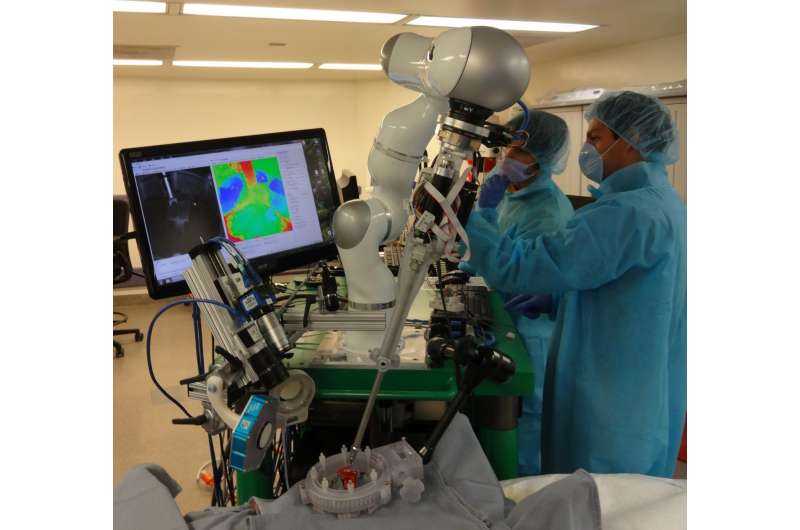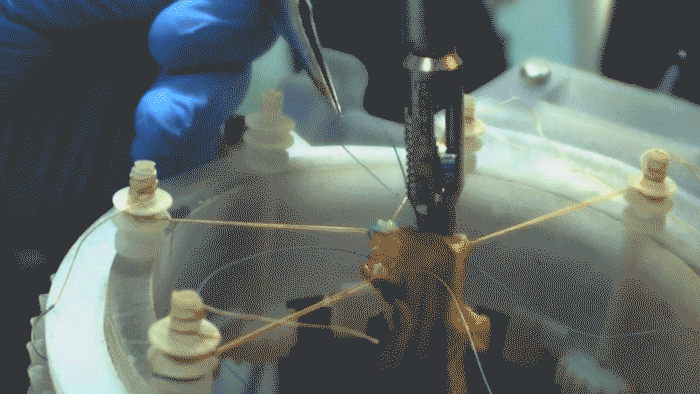Scientists program robot for 'soft tissue' surgery

Not even the surest surgeon's hand is quite as steady and consistent as a robotic arm built of metal and plastic, programmed to perform the same motions over and over. So could it handle the slippery stuff of soft tissues during a surgery?
Simon Leonard
, a Johns Hopkins University computer scientist, is part of a team that has just published research showing that a robot surgeon can indeed adjust to the subtle movement and deformation of soft tissue to execute precise and consistent suturing. The research, which
Leonard, an assistant research professor in the university's Whiting School of Engineering, worked with five co-authors, all affiliated with Children's National Health System in Washington, D.C.: Azad Shademan, Justin D. Opfermann, Peter C.W. Kim, Johns Hopkins alumnus Axel Krieger, and Ryan S. Decker.
"There's a wide range of skills out there" among surgeons, said Leonard, who worked for four years to program the robotic arm to precisely stitch together pieces of soft tissue. Putting a robot to work in this form of surgery "really levels the playing field."
Limited robotic automation is already used in surgeries involving rigid structures such as bones, which are much easier to hold still during the procedure. Soft tissue can move and change shape in complex ways as stitching goes on, requiring a surgeon's skill to respond to these changes and keep suturing as tightly and evenly as possible.

According to the researchers, more than 44.5 million soft-tissue surgeries are performed in the United States each year.
The published results involved suturing two structures. The procedure called anastomosis, meaning joining two tubular structures such as blood vessels, is performed over a million times a year in the United States. According to the researchers, complications such as leakage along the seams occur nearly 20 percent of the time in colorectal surgery and 25 to 30 percent of the time in abdominal surgery.
Robotic soft tissue surgery, the researchers wrote, "promises substantial benefits through improved safety from reduction of human errors and increased efficiency due to procedure time reduction." This surgery, however, can present a challenge in that it can be tricky for a robot to adjust to the soft tissue's slips and squirms during suturing.
To perform the experiment, the researchers developed a robotic surgical system called the Smart Tissue Autonomous Robot, or STAR. It features a 3D imaging system and a near-infrared sensor to spot fluorescent markers along the edges of the tissue to keep the robotic suture needle on track. Unlike other robot-assisted surgical systems, it operates under the surgeon's supervision, but without hands-on guidance.
The STAR robotic sutures were compared with the work of five surgeons completing the same procedure using three methods: open, laparoscopic and robot-assisted surgery. Researchers compared consistency of suture spacing, pressure at which the seam leaked, mistakes that required removing the needle from the tissue or restarting the robot, and completion time.
The robot's time was longer than open and robot-assisted surgery, but comparable to the laparoscopic procedure. The robotic procedure lasted 35 to 57 minutes, while the open surgery took eight minutes. By all other measures, the robot's performance was comparable to or better than the surgeons'.
"No significant differences in erroneous needle placement were noted among all surgical techniques," the researchers wrote, "suggesting that STAR was as dexterous as expert surgeons in needle placement."
It's not clear when the robotic system will be in use in operating rooms, but the researchers wrote that the intent is not to replace surgeons, but to "expand human capacity and capability."
As Leonard put it, they're designing an advanced surgical tool, "the equivalent of a fancy sewing machine."
More information: A. Shademan et al, Supervised autonomous robotic soft tissue surgery, Science Translational Medicine (2016). DOI: 10.1126/scitranslmed.aad9398


















